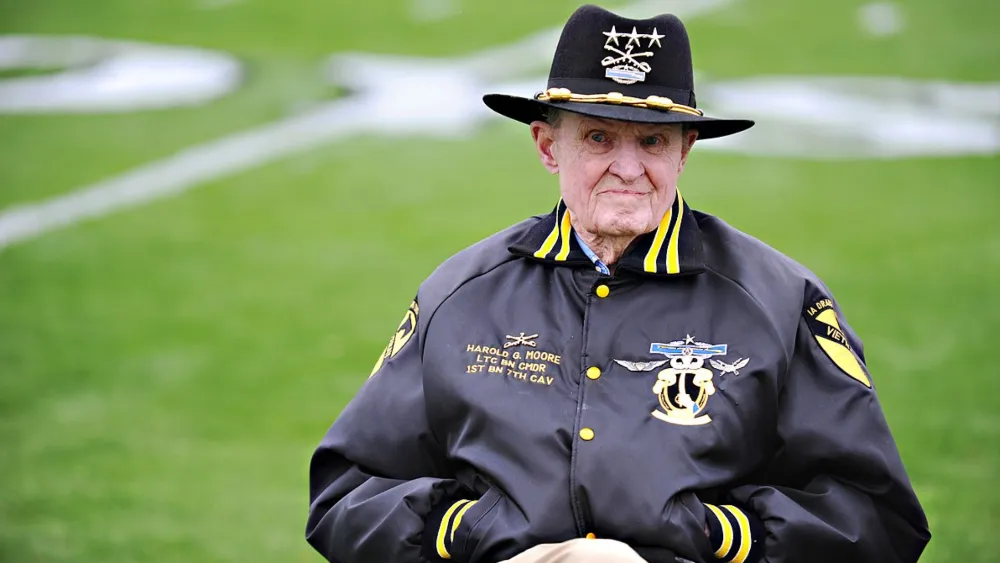Hal Moore is an accomplished author and retired lieutenant general in the U.S. Army. He was born on February 13, 1922, and passed away on February 10, 2017. Moore earned the United States Distinguished Service Cross, the Army’s second-highest decoration for valor. Moreover, he distinguished himself uniquely in his West Point class of 1945. He did it by rising to the ranks of major general, lieutenant general, and brigadier general.
Moore achieved acclaim for his leadership of the 1st Battalion, 7th Cavalry Regiment. Therefore, it shaped the outcome of the pivotal Battle of La Drang in 1965. This battle is a defining moment in the Vietnam War. At that time, he held the rank of lieutenant colonel. Moore’s 1992 best-selling book, “We Were Soldiers Once and Young,” vividly depicted the remarkable details of this battle. Soon it was later adapted into a motion picture in 2002.
Early Life and Education
Harold Sr. and Mary Moore had four children when Harold “Hal” Gregory Moore Jr, the eldest, was born in Bardstown, Kentucky, on February 13, 1922. His mother was a stay-at-home mom, and his father was an insurance agent whose territory included western Kentucky.
Moore completed his high school education at night while working during the day, graduating with the class of 1940 from Bardstown’s St. Joseph Preparatory School. Moore worked at his warehouse job.
He attended George Washington University night classes for two years while awaiting his appointment to West Point. During his time at George Washington University, he joined the Kappa Sigma fraternity.
After President Franklin D. Roosevelt ratified the laws, each senator and representative gained the authority to appoint additional members to the military and naval academies.
Representative Ed Creal of the 4th District of Kentucky extended Moore’s appointment to the United States Naval Academy. But Moore was not interested in attending.
Hal Moore: Military Service at West Point
The United States appointed Moore to the United States Military Academy soon after entering World War II. His report date was July 15, 1942, for “Reception Day” and the summer training program known as “Beast Barracks,” which took place at West Point before the official fall academic school term.
He was the highest scorer in his company and a qualified expert on the M-1 Garand rifle during his plebe summer at Pine Camp. Moore performed well in most classes but struggled academically in the required math courses.
He needed more effort to understand chemistry, physics, and engineering. After lights out, I frequently study for two or three hours to memorize the content.
In the fall of 1942, his class was informed that, due to the war, they would graduate in three years instead of the customary four. Moore described his plebe year as “an academic trip from hell.” He made it through, but not by much.
Hal Moore: Post World War II
After graduating, Moore’s assignment led him to the six-week Infantry Officer Basic Course at Fort Benning, Georgia. During the basic course, he applied to Fort Benning’s airborne jump school but was not accepted.
However, his orders directed him to the 11th Airborne Division’s three-week jump school in Tokyo, Japan. After completing jump school, his assignment placed him with the 187th Glider Infantry Regiment at Camp Crawford. Moreover, he rendered his service there from 1945 until 1948.
He served as company commander for seven months before being appointed as Camp Crawford’s construction officer. Here, he supervised all construction upgrades. In June 1948, he relocated to the 82nd Airborne Division at Fort Bragg.
On November 17, 1948, he made the first 150 jumps with the Airborne Test Section over the next two years after volunteering to join the elite unit that tested experimental parachutes. He accomplished over 300 jumps during his career to become a jumpmaster.
Leadership and Promotions in the Korean War
During the Korean War (1950–1953), his superiors ordered him to attend Fort Benning’s Infantry Officer’s Advanced Course in 1951. This course aimed to prepare him for commanding a company or fulfilling a role as a battalion staff member.
He commanded his heavy mortar unit as a captain in combat. His next role involved overseeing the regiment’s operations and plans as assistant chief of staff.
The commanding general of the 7th Division established a policy that blocked Moore from achieving the rank of major. This is until he had experience leading an infantry company in combat.
Moore was personally assigned to an infantry company by the division commander. It is for Moore to advance to the rank of major and eventually take over as the Division’s assistant chief of staff for operations.
Hal Moore: Post-Vietnam War Service
Following his service in the Vietnam War, the Pentagon employed Moore as the military liaison. This is between the Assistant Secretary for International Affairs and the Under Secretary of Defense. The Army sent him to Harvard University for his next assignment, where he completed his master’s program.
He played a crucial role in supporting the Army’s initiative to Vietnamize the war effort. On August 31, 1968, Moore received a promotion to the rank of brigadier general. In July 1969, he assumed the position of the Eighth Army’s assistant chief of staff for operations and planning in South Korea. During this period, incursions into the demilitarized zone heightened tensions. Moreover, Eighth Army soldiers experienced a significant surge in racism and drug use.

The Final Years of Hal Moore
Moore met Colonel and Mrs. Louis J. Compton’s daughter, Julia B. Compton, when he was assigned to Fort Bragg. Julia, a student at the University of North Carolina at Chapel Hill, was in Fort Bragg visiting her parents.
They married in the main post chapel at Fort Bragg on November 22, 1949.
Moore was the Executive President of the Colorado Crested Butte Ski Area following his retirement in 1977. The 87-year-old Moore was present at the National Infantry Museum’s official opening in Columbus, Georgia, in June 2009.
A life-size diorama of L.Z. is one of the museum’s highlight displays. An X-ray from the La Drang battle.
Three days before turning 95 years old, on February 10, 2017, Moore passed away due to a stroke. On February 17, 2017, he was buried with full military honors in Fort Benning Post Cemetery next to his late 55-year-wife. Who passed away in 2004.




